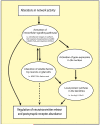Unraveling mechanisms of homeostatic synaptic plasticity
- PMID: 20471348
- PMCID: PMC3021747
- DOI: 10.1016/j.neuron.2010.04.028
Unraveling mechanisms of homeostatic synaptic plasticity
Abstract
Homeostatic synaptic plasticity is a negative feedback mechanism that neurons use to offset excessive excitation or inhibition by adjusting their synaptic strengths. Recent findings reveal a complex web of signaling processes involved in this compensatory form of synaptic strength regulation, and in contrast to the popular view of homeostatic plasticity as a slow, global phenomenon, neurons may also rapidly tune the efficacy of individual synapses on demand. Here we review our current understanding of cellular and molecular mechanisms of homeostatic synaptic plasticity.
Copyright 2010 Elsevier Inc. All rights reserved.
Figures


References
-
- Aakalu G, Smith WB, Nguyen N, Jiang C, Schuman EM. Dynamic Visualization of Local Protein Synthesis in Hippocampal Neurons. Neuron. 2001;30:489–502. - PubMed
-
- Abraham W, Goddard G. Asymmetric relationships between homosynaptic long-term potentiation and heterosynaptic long-term depression. Nature. 1983;305:717–719. - PubMed
Publication types
MeSH terms
Grants and funding
LinkOut - more resources
Full Text Sources

